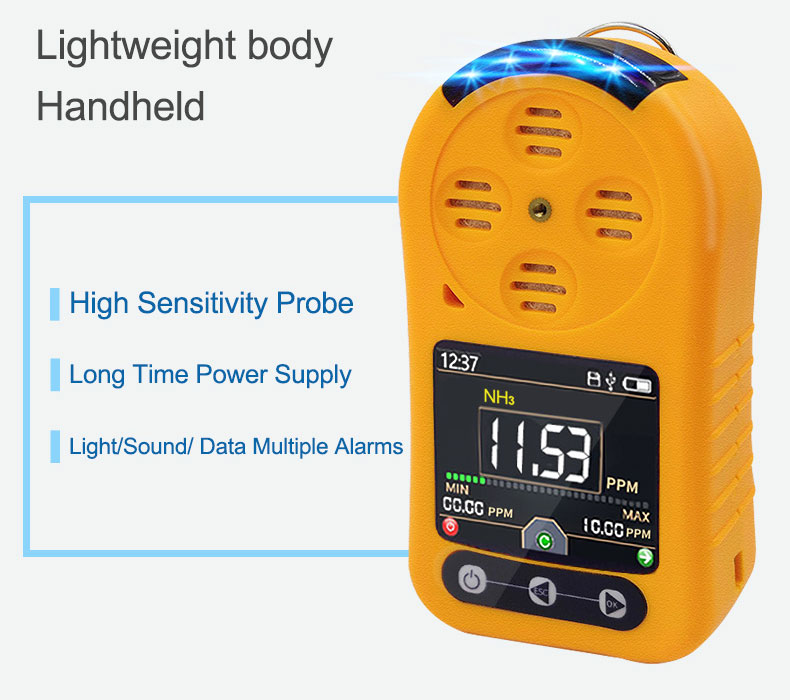Learn about hydrogen sulfide detector
This article will explore the importance of hydrogen sulfide detector and their role in ensuring safety in hazardous environments. Hydrogen sulfide is a colorless, flammable gas that has a distinctive odor similar to rotten eggs. Exposure to high levels of H2S can cause headaches, dizziness, nausea, and in extreme cases, death. To reduce these risks, hydrogen sulfide detectors have been developed that can monitor and warn hydrogen sulfide gas levels in real time.

Working Principle
A hydrogen sulfide detector is a portable or fixed device that utilizes advanced sensing technologies to detect and measure the concentration of H2S gas in the surrounding air. The most common detection methods include electrochemical, solid-state, and infrared sensors.

Electrochemical sensors work based on the principle of electrochemical reactions. When hydrogen sulfide gas comes into contact with the sensor’s electrode, a chemical reaction occurs, generating an electric current proportional to the gas concentration. This current is then converted into a digital signal, which is displayed on the detector’s screen as a numerical value representing the H2S concentration.
Solid-state sensors utilize a semiconductor material that reacts with hydrogen sulfide gas. When H2S molecules interact with the sensor, they cause changes in electrical conductivity.
Infrared sensors operate by emitting infrared light at specific wavelengths that are absorbed by hydrogen sulfide gas. By analyzing the amount of light absorbed, the detector can determine the concentration of H2S present in the environment.
Benefits and Applications
Hydrogen sulfide detectors offer several benefits in hazardous environments. First and foremost, they provide early warning of H2S gas leaks, enabling prompt evacuation or implementation of safety protocols. By continuously monitoring the gas concentration, these detectors can alert workers to potential dangers in real-time, allowing them to take immediate action to protect themselves and others.

Furthermore, hydrogen sulfide detectors promote workplace safety by ensuring compliance with occupational health and safety regulations. In industries where exposure to H2S is common, such as oil refineries and chemical plants, detectors are essential for maintaining a safe working environment. Regular monitoring of H2S levels helps to prevent accidents and reduce the risk of long-term health effects for workers.
Hydrogen sulfide detectors also play a crucial role in rescue operations. In the event of an accident or emergency situation, personnel equipped with detectors can assess the presence of H2S gas before entering a potentially dangerous area. This information allows for the development of effective strategies to rescue individuals and minimize further harm.
In addition, we often use hydrogen sulfide detectors in confined Spaces, such as underground mines and storage tanks. These enclosed environments are particularly prone to the accumulation of H2S gas, making continuous monitoring essential for worker safety. It is common to use a combination of detectors and centralized alarm systems to trigger an audible and visual alarm when the gas concentration exceeds a preset threshold.
It is worth mentioning that hydrogen sulfide detectors are also employed for environmental monitoring purposes. Industries that release H2S into the atmosphere, such as wastewater treatment plants, use detectors to measure emissions and ensure compliance with environmental regulations. By detecting and quantifying H2S levels, these detectors aid in pollution control efforts.
Conclusion
In hazardous environments where exposure to hydrogen sulfide gas is a constant concern, the use of hydrogen sulfide detectors is vital for ensuring the safety and wellbeing of workers. These detectors provide real-time monitoring, early warning of gas leaks, and compliance with safety regulations. They play a critical role in preventing accidents, protecting workers’ health, and enabling effective emergency response. By continuously monitoring H2S levels, hydrogen sulfide detectors contribute to a safer and healthier work environment, reducing the risks associated with hydrogen sulfide exposure.